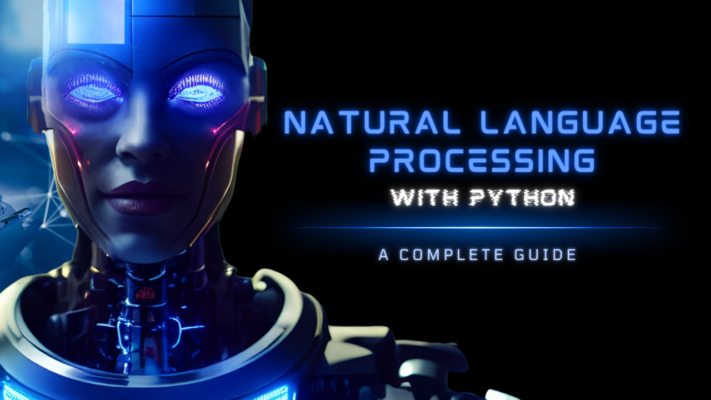
- May 2 2024
- admin
In our data-driven world, the ability to extract insights from vast amounts of unstructured text data has become increasingly vital for businesses and organizations. Natural Language Processing (NLP) is a field of artificial intelligence that focuses on enabling computers to understand, interpret, and generate human language. With the rise of NLP, organizations across various industries can unlock the potential of textual data, enabling them to make data-driven decisions, improve customer experiences, and drive innovation.
Python has emerged as the language of choice for NLP practitioners and researchers due to its extensive ecosystem of libraries and frameworks, ease of use, and strong community support. This comprehensive guide will introduce you to the world of Natural Language Processing with Python, exploring its key concepts, applications, industry use cases, and step-by-step implementation.
The Importance of Natural Language Processing
Natural Language Processing (NLP) has become increasingly important for several reasons:
1. Unlocking Value from Unstructured Data: A significant portion of data generated by businesses and organizations is in the form of unstructured text, such as emails, customer reviews, social media posts, and documents. NLP enables organizations to extract valuable insights from this data, which can inform decision-making processes and drive business strategies.
2. Enhancing Customer Experiences: NLP powers intelligent chatbots, virtual assistants, and recommendation systems that can understand and respond to customer queries, preferences, and behaviors, leading to improved customer satisfaction and engagement.
3. Automating and Streamlining Processes: NLP can automate and streamline various processes, such as document summarization, information extraction, content moderation, and legal document analysis, resulting in increased efficiency and cost savings.
4. Enabling Multilingual Communication: With the rise of globalization, NLP plays a crucial role in enabling seamless communication across languages through machine translation and multilingual language models.
5. Driving Innovation: NLP is a key enabler of innovative technologies, such as conversational AI, sentiment analysis, and knowledge discovery, fostering new products, services, and business models.
Benefits of Natural Language Processing with Python
Leveraging Natural Language Processing with Python offers numerous benefits for businesses and organizations:
1. Efficient Data Analysis: Python’s extensive NLP libraries and frameworks enable efficient processing and analysis of large volumes of textual data, providing valuable insights and supporting data-driven decision-making.
2. Improved Customer Interactions: NLP-powered chatbots, virtual assistants, and sentiment analysis tools can enhance customer interactions by providing personalized and responsive experiences, leading to increased customer satisfaction and loyalty.
3. Automated Information Extraction: NLP techniques can automatically extract relevant information from unstructured data sources, such as news articles, research papers, and legal documents, saving time and reducing manual effort.
4. Multilingual Support: Python’s NLP ecosystem offers robust support for multiple languages, enabling organizations to process and analyze textual data in various languages, catering to global markets and diverse audiences.
5. Seamless Integration: Python’s interoperability and ease of integration with other programming languages and systems make it a versatile choice for incorporating NLP capabilities into existing applications and workflows.
6. Cost-effective Solutions: Python’s open-source nature and large community support make it a cost-effective choice for developing NLP solutions, reducing development and maintenance costs.
Challenges and Considerations
While Natural Language Processing with Python offers numerous benefits, it also presents several challenges and considerations:
1. Data Quality and Preprocessing: Ensuring high-quality and properly preprocessed textual data is crucial for accurate NLP models and reliable results. Handling noisy, incomplete, or inconsistent data can be a significant challenge.
2. Computational Resources: Some NLP tasks, such as training large language models or processing massive datasets, can be computationally intensive, requiring substantial computational resources and potentially incurring high costs.
3. Domain-specific Knowledge: NLP models may require domain-specific knowledge and customization to achieve accurate results in specialized fields, such as legal, medical, or technical domains.
4. Interpretability and Explainability: Some NLP models, particularly deep learning-based models, can be opaque and difficult to interpret, making it challenging to explain their decision-making processes and ensure transparency.
5. Bias and Ethical Considerations: NLP models can inherit biases present in the training data or algorithms, potentially leading to unfair or discriminatory outcomes. Addressing these biases and upholding ethical principles is crucial.
6. Continuous Learning and Adaptation: Language is constantly evolving, and NLP models may require continuous learning and adaptation to stay relevant and accurate over time.
Pros and Cons of Natural Language Processing with Python
Like any technology, Natural Language Processing with Python has its advantages and disadvantages. Here are some of the key pros and cons:
Pros:
1. Rich Ecosystem: Python boasts a vast and growing ecosystem of NLP libraries and frameworks, providing a wide range of tools and pre-trained models for various NLP tasks.
2. Easy to Learn: Python’s simple and intuitive syntax makes it relatively easy to learn and understand, especially for beginners or those transitioning from other programming languages.
3. Extensive Documentation and Community Support: Python has a large and active community, providing extensive documentation, tutorials, and online resources, making it easier to find solutions and seek support.
4. Interoperability and Integration: Python can seamlessly integrate with other programming languages and technologies, enabling the incorporation of NLP capabilities into larger systems and applications.
5. Cross-platform Compatibility: Python is cross-platform compatible, allowing NLP applications and models to run on various operating systems without significant modifications.
Cons:
1. Performance Limitations: While Python is versatile, it may have performance limitations compared to lower-level programming languages, particularly for computationally intensive NLP tasks.
2. Memory Management: Python’s dynamic memory management can sometimes lead to memory inefficiencies, especially when working with large datasets or complex NLP models.
3. Library Dependencies: Relying on third-party libraries and frameworks can introduce potential compatibility issues, security vulnerabilities, and maintenance challenges as these dependencies evolve.
4. Varied Coding Styles: Python’s flexibility in coding styles can lead to inconsistencies and potential maintainability issues, especially in large-scale projects with multiple contributors.
5. Limited Native Support for Parallel Computing: While Python supports parallel computing through libraries like NumPy and Dask, its native support for parallel computing is relatively limited compared to languages like Java or C++.
A Detailed Guide to Natural Language Processing with Python
To help you get started with Natural Language Processing using Python, we’ve prepared a step-by-step guide covering the essential topics and techniques:
1. Setting up the Environment
- Installing Python and the necessary packages (e.g., NLTK, spaCy, Gensim, Transformers)
- Setting up a Python development environment (e.g., Jupyter Notebook, PyCharm, Visual Studio Code)
2. Text Preprocessing
- Tokenization: Breaking text into smaller units (words, sentences, or other tokens)
- Normalization: Converting text to a consistent format (e.g., lowercase, removing accents)
- Stop word removal: Removing common, non-informative words (e.g., “the”, “and”, “is”)
- Stemming and lemmatization: Reducing words to their base or root form
- Handling special characters and encoding
3. Feature Extraction and Representation
- Bag-of-Words (BoW) and Term Frequency-Inverse Document Frequency (TF-IDF)
- Word embeddings (e.g., Word2Vec, GloVe, FastText)
- Contextual embeddings (e.g., ELMo, BERT, GPT)
4. Text Classification
- Supervised learning algorithms (e.g., Naive Bayes, Logistic Regression, Support Vector Machines
- Deep learning models (e.g., Convolutional Neural Networks, Recurrent Neural Networks)
- Transfer learning with pre-trained language models (e.g., BERT, RoBERTa, XLNet)
5. Named Entity Recognition (NER)
- Rule-based NER
- Statistical and machine learning-based NER
- Deep learning-based NER (e.g., BiLSTM-CRF, Transformer-based models)
6. Sentiment Analysis
- Rule-based sentiment analysis
- Machine learning-based sentiment analysis (e.g., Naive Bayes, Support Vector Machines)
- Deep learning-based sentiment analysis (e.g., Recurrent Neural Networks, Transformer-based models)
7. Topic Modeling
- Latent Dirichlet Allocation (LDA)
- Non-negative Matrix Factorization (NMF)
- Guided LDA and Seeded LDA
8. Text Summarization
- Extractive summarization techniques (e.g., TextRank, LexRank)
- Abstractive summarization with deep learning (e.g., Sequence-to-Sequence models, Transformer-based models)
9. Machine Translation
- Statistical Machine Translation (SMT)
- Neural Machine Translation (NMT) with Sequence-to-Sequence models
- Transformer-based models (e.g., Transformer, BART, mBART)
10. Information Extraction
- Named Entity Recognition (NER) for information extraction
- Relation Extraction
- Event Extraction
- Open Information Extraction
11. Natural Language Generation
- Template-based generation
- Retrieval-based generation
- Deep learning-based generation (e.g., Sequence-to-Sequence models, Transformer-based models)
12. Evaluation and Deployment
- Evaluation metrics for different NLP tasks (e.g., accuracy, F1-score, BLEU)
- Deploying NLP models as APIs or integrating them into applications
- Continuous learning and model updates
Throughout this guide, you’ll explore code examples, best practices, and real-world use cases to solidify your understanding of Natural Language Processing with Python. Additionally, you’ll learn about the latest trends and advancements in the field, such as few-shot learning, multi-modal models, and ethical AI considerations.
Industry Use Cases and Applications
Natural Language Processing with Python has numerous applications across various industries, enabling organizations to unlock the value of textual data and drive innovation. Here are some notable industry use cases:
1. Customer Service and Chatbots
- Intelligent chatbots and virtual assistants for customer support, sales, and information retrieval
- Analyzing customer queries and conversations for sentiment analysis and intent recognition
2. Sentiment Analysis and Social Media Monitoring
- Monitoring brand reputation and public opinion by analyzing social media posts and reviews
- Identifying potential customer issues or opportunities for improvement
3. Document Summarization and Information Extraction
- Automatically summarizing long documents, reports, and research papers
- Extracting key information from legal contracts, patents, and other complex documents
4. Machine Translation
- Enabling real-time translation between languages for global business operations
- Translating customer support inquiries, product documentation, and marketing materials
5. Healthcare and Biomedical Research
- Analyzing electronic medical records and clinical notes for improved diagnosis and treatment
- Extracting insights from biomedical research papers and clinical trial data
6. Legal and Contract Analysis
- Automating the review and analysis of legal documents, contracts, and regulations
- Identifying key clauses, risks, and compliance issues
7. E-commerce and Recommendation Systems
- Analyzing product descriptions, customer reviews, and user behavior for personalized recommendations
- Improving search functionality and product categorization
8. Spam Detection and Content Moderation
- Identifying and filtering out spam, hate speech, and other harmful content
- Ensuring a safe and positive online environment for users
9. News and Media
- Automating news article generation and content curation
- Analyzing and summarizing news articles for content discovery and personalization
10. Finance and Banking
- Analyzing financial reports, market research, and customer communications
- Automating document processing and information extraction for regulatory compliance
These use cases demonstrate the versatility and impact of Natural Language Processing with Python across various domains, highlighting its potential to drive business value, enhance customer experiences, and foster innovation.
Conclusion
Natural Language Processing with Python offers a powerful toolkit for unlocking the value hidden within textual data. By leveraging Python’s extensive NLP ecosystem, organizations can gain valuable insights, automate processes, and enhance decision-making across various domains.
As the demand for NLP skills continues to rise, mastering Python and its NLP libraries and frameworks can position you at the forefront of this rapidly evolving field. Whether you’re a developer, data scientist, or researcher, Natural Language Processing with Python presents a versatile and accessible approach to tackling a wide range of language-related challenges.
However, it’s crucial to navigate the challenges and considerations associated with NLP, such as data quality, computational resources, domain-specific knowledge, interpretability, bias, and ethical implications. By addressing these challenges and continuously learning and adapting, you can develop robust and responsible NLP solutions that drive meaningful impact.
If you’re looking to leverage the power of Natural Language Processing and unlock the potential of your textual data, consider partnering with Upcore Technologies. Our team of experienced data scientists and NLP experts can guide you through the entire process, from data preparation and model development to deployment and integration. With our cutting-edge NLP solutions and deep industry knowledge, we can help you extract valuable insights, automate processes, and gain a competitive edge in your respective market.
Embrace the world of Natural Language Processing with Python, and embark on a journey to unlock the hidden value within your textual data, driving innovation and business success in the era of big data and artificial intelligence.


